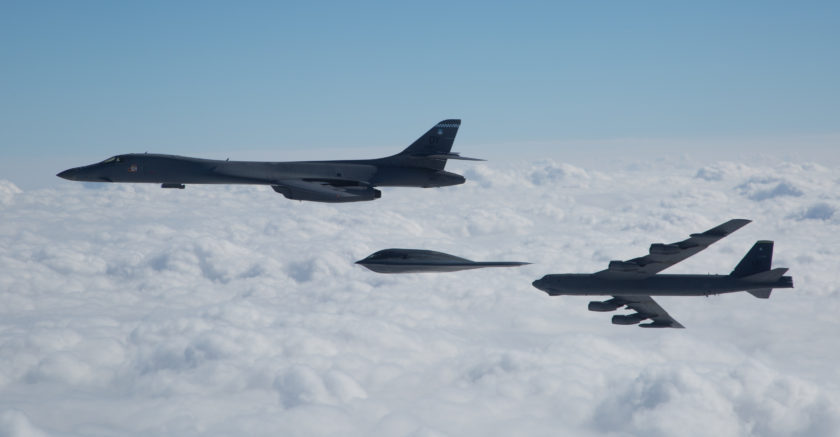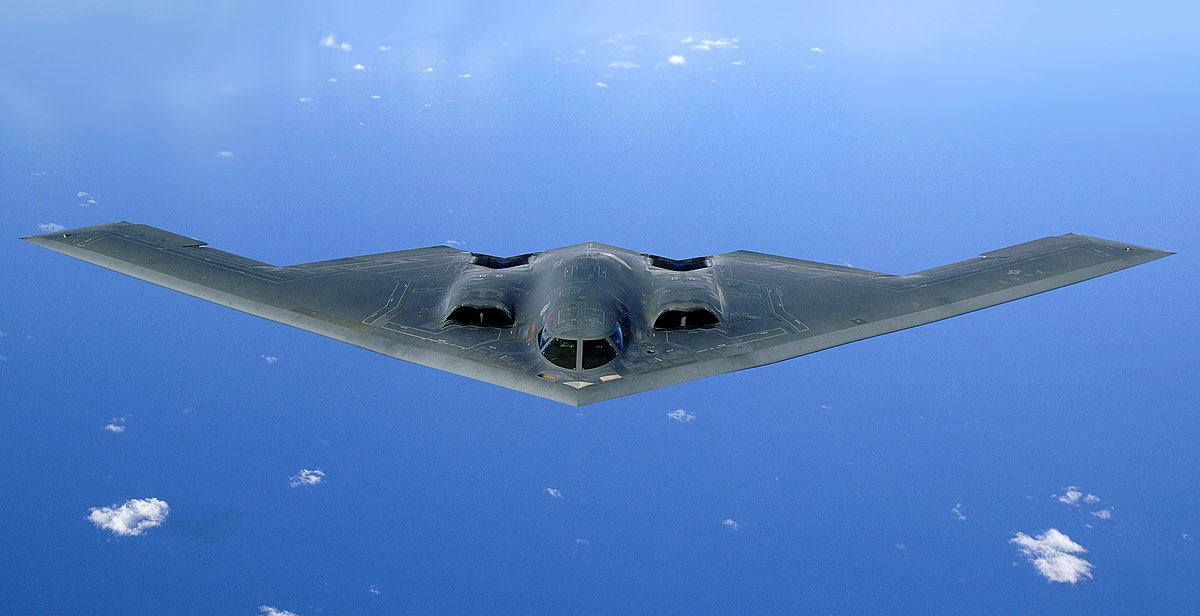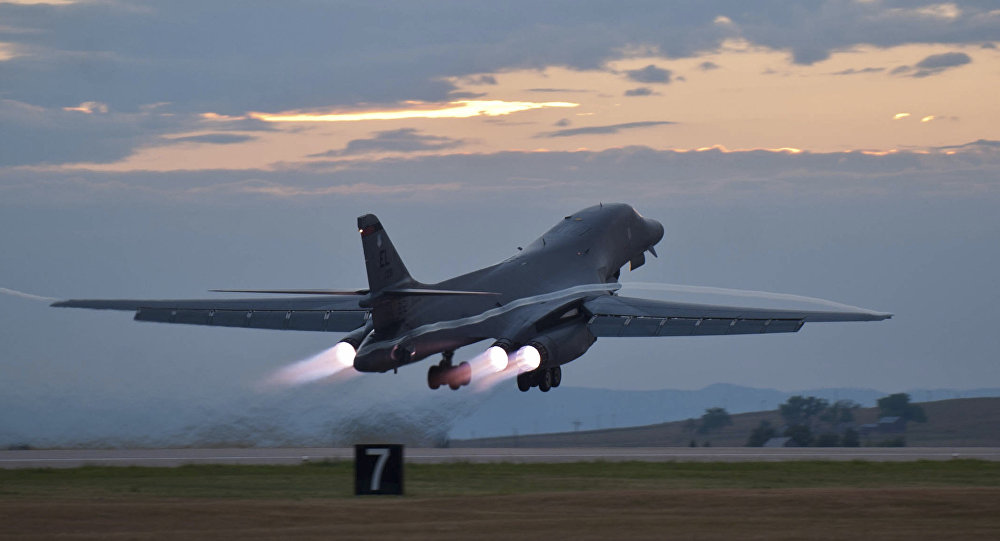USAF Bombers
The three main types of bombers are key to the US nuclear deterrent, but in recent years have also become important in the conventional strike role. Ranging in age from 35-year-old B-52G’s to brand new B-2 Spirit only entering service in the past few weeks and months, the bomber force is as diverse as it is powerful.

The eight newly minted B-2 Spirit bombers have been rushed into service and formed the 393rd Bomb Squadron at Whiteman AFB. Two of the eight aircraft are still being used as testbeds to finalize systems calibration and procedures. The remaining aircraft are kept busy qualifying crews and fine tuning attack procedures. The high degree of stealth, advanced avionics and automated systems, long range and large bombload make this aircraft very potent. Aircraft in the squadron tend to fly singly on missions and have not yet qualified on multi-aircraft night penetration tasks, some argue that there is no need to do so and that a single bomber is powerful enough on its own. Aircraft on the squadron are listed below and the next one off the assembly line (Spirit of Nebraska) is expected in March 94 with another roughly every 2-3 months after that until all 21 are delivered:
AV-5 Spirit of Ohio ATEC Testbed
AV-6 Spirit of Mississippi ATEC Testbed
AV-7 Spirit of Texas
AV-8 Spirit of Missouri
AV-9 Spirit of California
AV-10 Spirit of South Carolina
AV-11 Spirit of Washington
AV-12 Spirit of Kansas

Nicknamed the ‘Bone’ (B-ONE), 95 of the original 100 airframes remain in service. These supersonic bombers have variable swept wings and a blended wing body with four massive engines. It was designed to be a Mach 2+ nuclear delivery system; however, when production aircraft started entering service in 1985 they were limited in speed to Mach 1.25 (950 mph or 1,530 kph) in order to increase efficiency and avoid structural damage. After production, their role changed due to the high level SAM threat, their low level speed which was increased to Mach 0.92 (700 mph, 1,130 kph) combined with the use of an advanced terrain following radar made them a formidable low level penetrator, at the time however they were still only able to use nuclear munitions. Their high speed, advanced sensors, avionics and electronic countermeasures made this a much more survivable aircraft than the B-52, which it was replacing in the nuclear strike and deterrence role. A limited ability to drop conventional munitions was added in 1990 and with the downfall of SAC (Strategic Air Command), the bombers were transferred to ACC (Air Combat Command) who had a much greater interest in using these platforms in conventional fights. They did not participate in the Gulf War due to limitations on use caused by engine fires, which has since been rectified. By 1994 the ‘Bones’ could drop general purpose and cluster munitions from both low and high altitude, but were unable to use precision guided munitions. Two wings of B-1Bs operate the majority of the airframes for ACC as well as the 46th Bomb squadron which conducts training, testing and evaluation for ATEC.
| Wing | Squadron | Name | Base | # of AC | Type |
|---|---|---|---|---|---|
| 7th Bomb Wing | 9 BS | Bats | Dyess AFB | 15 | B-1B |
| 7th Bomb Wing | 28 BS | Mohawks | Dyess AFB | 15 | B-1B |
| 7th Bomb Wing | 337 BS | Griffons | Dyess AFB | 15 | B-1B |
| 28th Bomb Wing | 34 BS | Doolittle's Raiders | Ellsworth AFB | 15 | B-1B |
| 28th Bomb Wing | 37 BS | Tigers | Ellsworth AFB | 15 | B-1B |
| 28th Bomb Wing | 77 BS | Blue Lightning | Ellsworth AFB | 15 | B-1B |

The venerable B-52 Stratofortress, the mainstay of SAC’s bombing force for three decades was more commonly known as the BUFF (Big Ugly Fat … Fella), and was universally recognized around the world as a symbol of American military power. Of the 744 produced over 10 years in eight major versions, only about 200 of the latest models remain in service. Still serving in four bomb wings are 99 of the original 102 B-52H models and 96 of the original 193 B-52G. There are about 90 ‘G’ models in storage, tentatively awaiting destruction due to the START I (Strategic Arms Reduction Treaty) settlement, which was agreed with the previous Soviet government and neither renounced nor ratified by either side after the Soviet Coup of ‘91. The fundamental difference between the ‘G’ and the ‘H’ are the engines which are much more powerful and efficient as well as improved tail gun, avionics, targeting and electronic countermeasures (ECM) in the ‘H’. More ‘G’ models were retained in service than was historically the case due to uncertainty in the START negotiations, but both models were being modified to be more conventionally capable by ACC. The ‘G’ model could engage shipping targets with the AGM-84D Harpoon missile while the ‘H’ models were fitted with the AGM-86C CALCM (Conventional Land Attack Cruise Missile), both were undergoing a constant series of ECM upgrades. The B-52 played a significant role in the Gulf War, some flying from the US and returning home, capturing the record for longest distance combat mission from the British ‘Black Buck’ missions executed during the Falkland Islands campaign.

| Wing | Squadron | Name | Base | # of AC | Type |
|---|---|---|---|---|---|
| 2nd Bomb Wing | 11 BS | Mr Jiggs | Barksdale AFB | 16 | B-52H |
| 2nd Bomb Wing | 20 BS | The Buccaneers | Barksdale AFB | 16 | B-52H |
| 2nd Bomb Wing | 96 BS | Red Devils | Barksdale AFB | 16 | B-52H |
| 5th Bomb Wing | 23 BS | Bomber Barons | Minot AFB | 16 | B-52H |
| 5th Bomb Wing | 31 BS | Desert Pirates | Minot AFB | 16 | B-52H |
| 5th Bomb Wing | 72 BS | Lightning | Minot AFB | 16 | B-52H |
| 57th Bomb Wing | 39 BS | Night Wings | Carswell AFB | 16 | B-52G |
| 57th Bomb Wing | 40 BS | Fightin' 40th | Carswell AFB | 16 | B-52G |
| 57th Bomb Wing | 69 BS | Knighthawks | Carswell AFB | 16 | B-52G |
| 307th Bomb Wing | 93 BS | Indian Outlaws | Barksdale AFB | 16 | B-52G |
| 307th Bomb Wing | 343 BS | Avengers | Barksdale AFB | 16 | B-52G |
| 307th Bomb Wing | 340 BS | Mailed Fist | Barksdale AFB | 16 | B-52G/H |